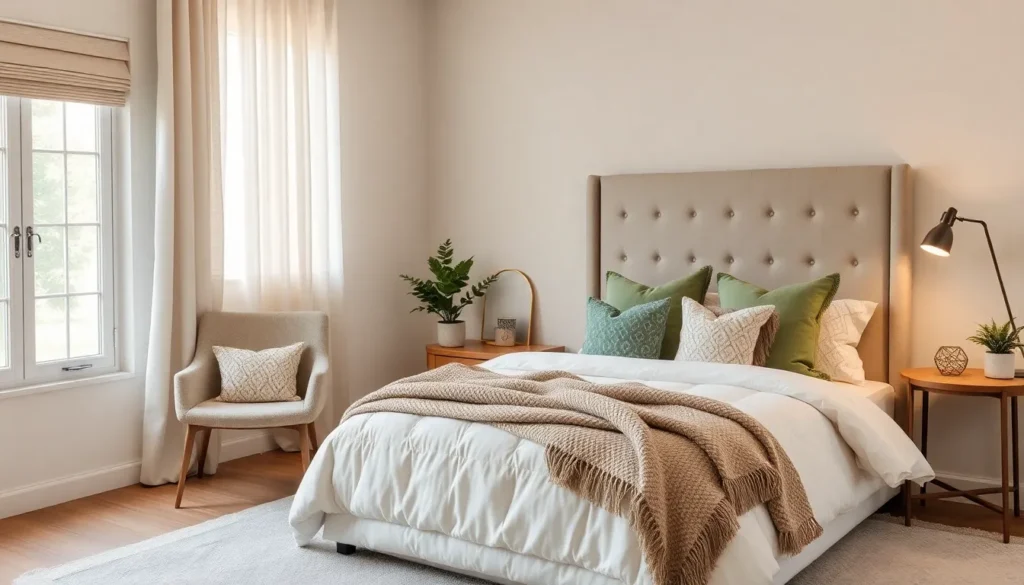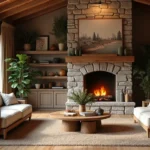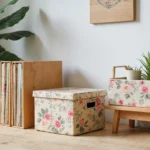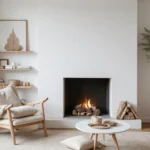We spend roughly one-third of our lives in our bedrooms yet many of us treat this sacred space as an afterthought. Your bedroom should be more than just a place to sleep – it’s your personal sanctuary where you start and end each day. The right decor can transform your space from bland to breathtaking while creating the perfect atmosphere for rest and relaxation.
Whether you’re working with a cozy apartment bedroom or a spacious master suite we’ve got you covered. From budget-friendly DIY projects to luxurious statement pieces there are countless ways to elevate your bedroom’s style without very costly.
Ready to turn your bedroom into the retreat you’ve always dreamed of? We’ll walk you through proven design strategies that’ll help you create a space that’s both beautiful and functional. Let’s explore the bedroom decor ideas that’ll make you actually excited to spend time in your room.
Choose a Cohesive Color Palette That Sets the Mood
Color schemes form the foundation of effective bedroom decor, influencing our emotional state and sleep quality. We’ll explore three distinct approaches to help you create the perfect atmosphere for your personal retreat.
Warm Neutrals for a Cozy Atmosphere
Beige, cream, and soft taupe tones create an inviting environment that promotes relaxation and comfort. These versatile shades work particularly well in bedrooms with limited natural light, as they reflect warmth throughout the space. Layering different textures in similar neutral tones adds visual interest without overwhelming the senses.
Incorporate warm wood finishes like oak or walnut to complement your neutral palette. Soft whites and off-whites serve as perfect accent colors, creating contrast while maintaining the cozy feeling. Consider adding touches of warm gray or mushroom tones through bedding, curtains, or decorative pillows to enhance depth and sophistication.
Cool Tones for a Calming Retreat
Blue, green, and lavender hues naturally lower stress levels and encourage restful sleep. Pale blues reminiscent of clear skies create an airy, spacious feeling in smaller bedrooms. Sage green brings nature indoors while maintaining a serene atmosphere that supports relaxation.
Gray serves as an excellent base color when paired with cool accent tones. Soft purples and muted teals work beautifully as secondary colors in bedding or artwork. These calming shades reduce visual stimulation, making them ideal for people who struggle with sleep or anxiety.
Bold Accent Colors for Personality
Vibrant colors like deep emerald, rich burgundy, or golden yellow can transform a neutral bedroom into a ever-changing personal space. We recommend limiting bold colors to 20-30% of your overall color scheme to maintain balance. Statement walls, colorful artwork, or striking bedding serve as perfect vehicles for introducing personality through color.
Jewel tones such as sapphire blue or amethyst purple create luxury and sophistication when used sparingly. Bright coral or sunny orange accents energize the space while still allowing for peaceful rest. Balance these intense colors with plenty of white or neutral tones to prevent visual overwhelm.
Create a Stunning Focal Point With Your Headboard

Your headboard serves as the bedroom’s central design anchor, visually defining the space while creating a stunning focal point. We’re seeing designers in 2025 embrace softer, rounded forms that promote tranquility and elegance throughout the bedroom.
DIY Headboard Ideas on a Budget
Building your own headboard opens up endless customization possibilities without very costly. Repurpose old doors by sanding them down and applying a fresh coat of paint or stain to match your bedroom’s aesthetic. Transform reclaimed wood planks into a rustic statement piece by arranging them vertically or horizontally behind your bed.
Create fabric panel headboards by mounting batting and your favorite textile onto plywood backing. Paint a geometric design or mural directly onto the wall behind your bed for an artistic approach that costs only the price of paint. Fashion no-sew upholstered headboards using foam padding, batting, and fabric secured with a staple gun for professional-looking results.
Browse Pinterest and home decor blogs for step-by-step tutorials that make use of affordable materials like pegboard, woven baskets, or even vinyl records for unique conversation starters.
Upholstered Headboards for Luxury Appeal
Upholstered headboards instantly elevate your bedroom with rich texture and sophisticated luxury appeal. We’re gravitating toward plush fabrics like velvet, linen, and bouclé in 2025, particularly in deep jewel tones and soft neutrals that create inviting atmospheres.
Choose tufted designs for classic elegance or opt for customized styles with clean lines for modern bedrooms. Consider unique curved shapes that soften the room’s overall aesthetic while providing comfortable back support for reading or lounging. Layer different textures through your headboard choice to achieve that collected, curated look that mixes styles and eras seamlessly.
Select rich burgundy velvet for dramatic impact or cream linen for timeless sophistication. These tactile materials contribute to cozy, welcoming environments that invite relaxation and rest.
Statement Wall Behind the Bed
Transform your bedroom’s focal point by creating a bold statement wall that draws attention and sets the entire room’s mood. Apply floral or geometric patterned wallpaper for instant visual drama, or choose textured finishes that add depth and dimension to your space.
Install wood paneling or stone accents for natural warmth and organic appeal. Embrace color drenching by covering your walls, trim, and ceiling in one bold hue for an immersive, cocoon-like effect that feels both modern and intimate.
Layer framed artwork at varying heights to create gallery-style visual interest. Mount floating shelves to display decorative objects, books, or plants that reflect your personality and story. Consider board and batten wainscoting painted in contrasting colors to add architectural detail and sophistication to your bedroom retreat.
Layer Textures and Fabrics for Visual Interest

Textural layering stands as a defining trend in 2025 bedroom decor, transforming spaces through sensory-rich combinations of materials and finishes. We’ll explore how mixing plush rugs, velvet cushions, and woven throws creates visual depth while improving the overall warmth of your space.
Mix Different Bedding Materials
Cotton serves as an excellent foundation for your bedding ensemble, offering breathability and easy maintenance. Linen adds relaxed sophistication with its naturally wrinkled texture and temperature-regulating properties. Silk introduces luxurious sheen and smooth coolness that contrasts beautifully with rougher textures.
Combining these three materials creates a rich tapestry of sensations and visual appeal. Cotton percale sheets provide crisp freshness, while a linen duvet cover adds casual elegance. Silk pillowcases complete the trio by offering hair and skin benefits alongside their lustrous appearance.
Weight variations enhance the layering effect when you pair lightweight cotton with heavier linen or substantial silk throws. Different weaves within the same material family, such as jersey cotton with percale cotton, multiply your textural options without overwhelming the color scheme.
Add Throw Pillows and Blankets
Throw pillows introduce instant color and pattern flexibility to your bedroom design. Velvet pillows provide rich texture against smooth sheets, while knitted covers add cozy dimension. Faux fur options bring luxury and warmth during colder months.
Strategic placement maximizes visual impact when you arrange pillows in odd numbers, typically three or five per side. Different sizes create depth, with larger pillows in back and smaller accent pieces in front. Mixing geometric patterns with organic shapes keeps the arrangement ever-changing yet balanced.
Layered blankets extend the textural story beyond the bed itself. Chunky knit throws draped over bedside chairs add sculptural interest. Lightweight cashmere throws folded at the foot of the bed provide both function and style. Woven wool blankets introduce traditional craftsmanship elements that complement modern bedding.
Incorporate Area Rugs and Curtains
Area rugs ground the bedroom space with warmth and visual weight beneath your feet. Placing rugs partially under the bed, extending at least 18 inches on each side, creates proper proportion. Natural fiber rugs like jute provide organic texture, while Persian or vintage styles add pattern complexity.
Floor-to-ceiling curtains create dramatic vertical lines that enhance room height perception. Heavy fabrics like velvet or thick cotton provide excellent light control and acoustic benefits. Sheer panels layered behind heavier curtains offer privacy options while maintaining natural light flow.
Rug and curtain coordination strengthens your textural theme without requiring exact matches. Similar color temperatures tie the elements together, such as warm beige rugs with cream curtains. Contrasting textures work effectively when colors complement each other, like smooth silk curtains paired with nubby wool rugs.
Maximize Storage While Maintaining Style
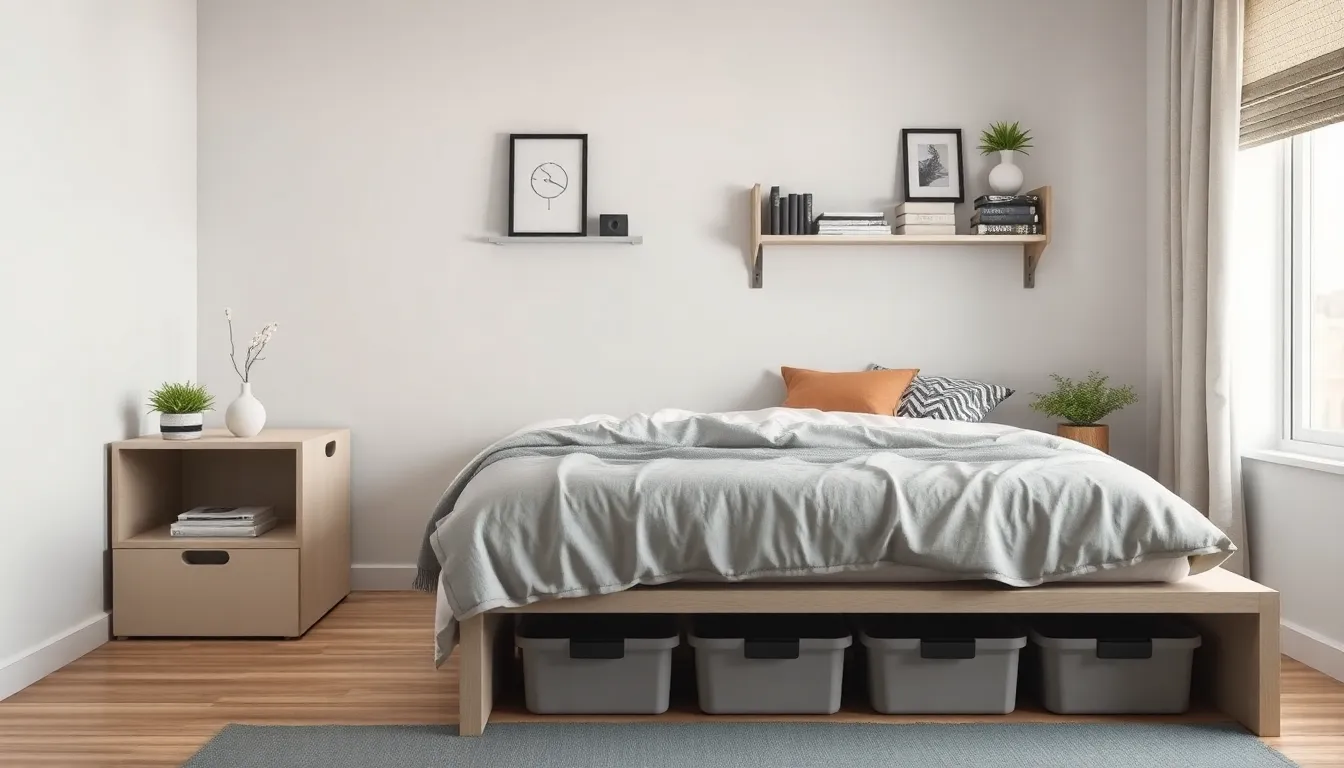
We understand that creating a beautiful bedroom doesn’t mean sacrificing functionality. Smart storage answers help us maintain a clutter-free sanctuary while preserving the aesthetic appeal we’ve carefully crafted through color palettes and layered textures.
Under-Bed Storage Answers
Under-bed storage containers transform unused space beneath our beds into valuable organizational real estate. We can choose from clear bins for easy visibility, fabric boxes that complement our decor, or rolling containers that provide effortless access to stored items.
Storage options range from sturdy wheeled boxes to sliding drawers that integrate seamlessly with bed frames. High-quality containers feature smooth gliding mechanisms and secure closures that protect our belongings from dust and moisture.
This hidden storage works perfectly for out-of-season clothing, extra linens, shoes, and accessories we don’t need daily. Rolling storage makes it simple to access items without lifting heavy containers, while clear bins let us quickly identify contents without opening each box.
Stylish Nightstand Alternatives
Wall-mounted shelves replace bulky traditional nightstands while creating visual lightness in our bedroom space. We can install floating night tables that appear to hover beside our beds, offering storage without overwhelming smaller rooms.
Repurposed furniture like small bookshelves, vintage stools, or ladder shelves adds character while serving our bedside needs. These creative alternatives often include built-in drawers or open cubbies that store books, glasses, and nighttime essentials.
Multi-functional pieces work especially well in compact bedrooms where every square foot matters. Stackable cubes, narrow console tables, or even hanging organizers can hold our bedside items while maintaining the clean aesthetic we’ve established through our carefully chosen color schemes.
Built-In Shelving and Closet Organization
Built-in shelves maximize vertical space and transform awkward corners into functional storage areas. We can add shelving above windows, doors, or in narrow spaces between walls to keep everyday items organized and accessible.
Customized closet systems use every inch of available space through modular organizers, pull-out drawers, and specialized hanging answers. These integrated systems include shoe racks, tie organizers, and adjustable shelving that adapts to our changing storage needs.
Modular closet components allow us to create personalized organization systems that grow with our wardrobe requirements. Professional installation ensures these built-ins match our room’s design aesthetic while providing maximum functionality for years to come.
Incorporate Proper Lighting for Ambiance and Function
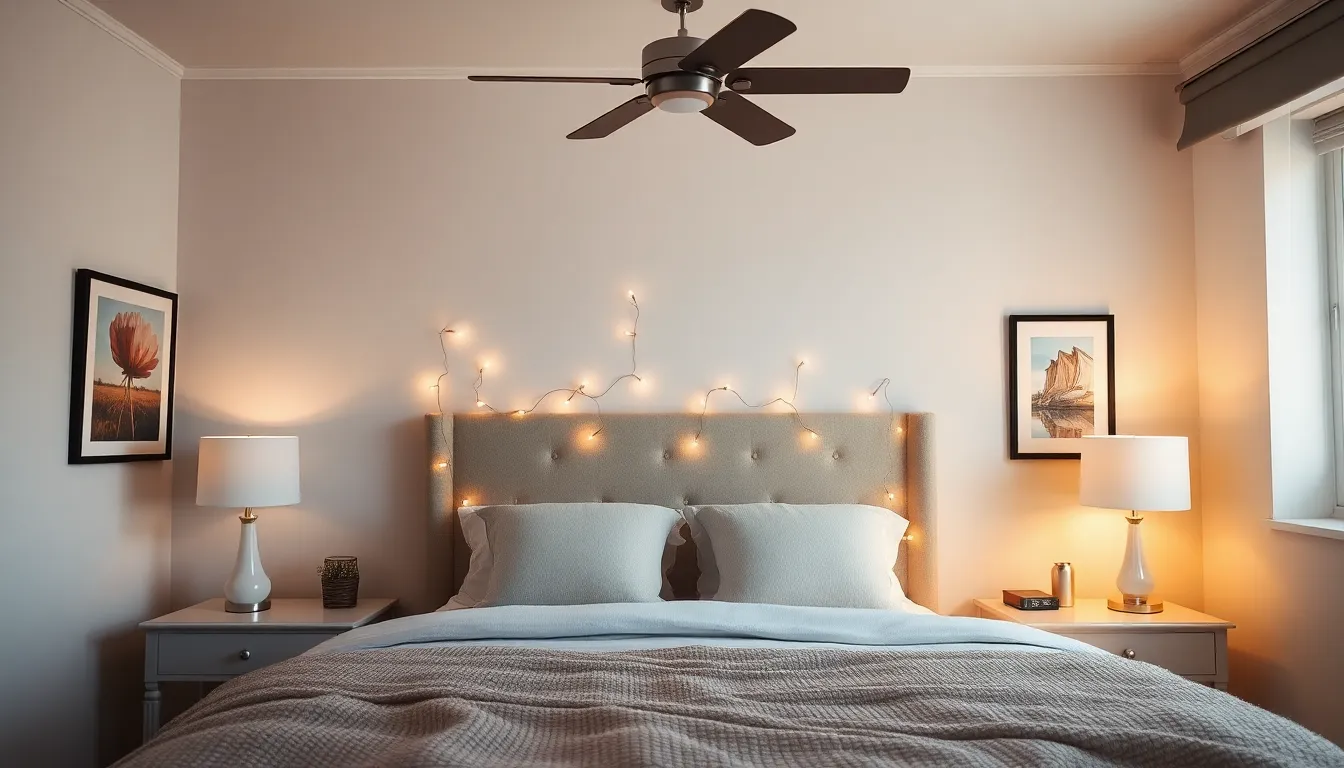
Effective bedroom lighting combines style with functionality to create the perfect atmosphere for rest and daily activities. We’ll explore strategic lighting placement that transforms your bedroom into a versatile sanctuary.
Bedside Table Lamps and Sconces
Matching bedside table lamps create symmetry that anchors your bed in a light, neutral space. These twin fixtures add a graphic touch while providing essential task lighting for reading and nighttime routines. Position lamps at eye level when you’re sitting in bed to minimize glare and maximize comfort.
Wall-mounted sconces offer a space-saving alternative that provides subtle ambiance. Mount these fixtures 24-30 inches above your mattress to create the perfect reading nook without cluttering your nightstand. Sconces work especially well in smaller bedrooms where table space is limited.
Dimmer switches on bedside lighting allow you to adjust brightness throughout the day. Morning routines require brighter illumination while evening wind-down benefits from softer, warmer light. This flexibility makes your bedroom lighting adapt to your changing needs.
Overhead Lighting Options
Central ceiling fixtures provide ambient lighting that sets your room’s overall mood. Modern ceiling lights and flush-mount fixtures distribute light evenly throughout the space. Choose fixtures with warm LED bulbs to create a cozy atmosphere that complements your bedroom’s color palette.
Antique chandeliers create striking focal points when paired with modern table lamps. This combination balances traditional elegance with contemporary functionality. Position chandeliers over seating areas or in the center of larger bedrooms to maximize their visual impact.
Recessed lighting offers clean, unobtrusive overhead illumination. Install multiple recessed lights on dimmer controls to create customizable ambient lighting. Space fixtures 4-6 feet apart for even light distribution without harsh shadows.
String Lights and Accent Lighting
String lights add whimsical charm as accent lighting that creates cozy ambiance. Drape these lights around headboards, window frames, or ceiling perimeters for a soft, romantic glow. Battery-operated options offer placement flexibility without visible cords.
Accent lighting highlights architectural features and artwork to enhance visual interest. Picture lights, uplights, and small spotlights draw attention to your bedroom’s unique design elements. This layered approach adds depth and dimension to your space.
LED strip lighting behind headboards creates a subtle backlight effect. This modern accent technique makes your headboard appear to float while providing gentle illumination for nighttime navigation. Choose warm white LEDs to maintain a cozy bedroom atmosphere.
Combining ambient, task, and accent lighting creates the most versatile bedroom environment. Central fixtures handle overall illumination, bedside lamps provide focused light for activities, and accent pieces highlight your room’s best features. This three-layer approach ensures your bedroom lighting meets every need throughout the day.
Add Personal Touches With Art and Accessories
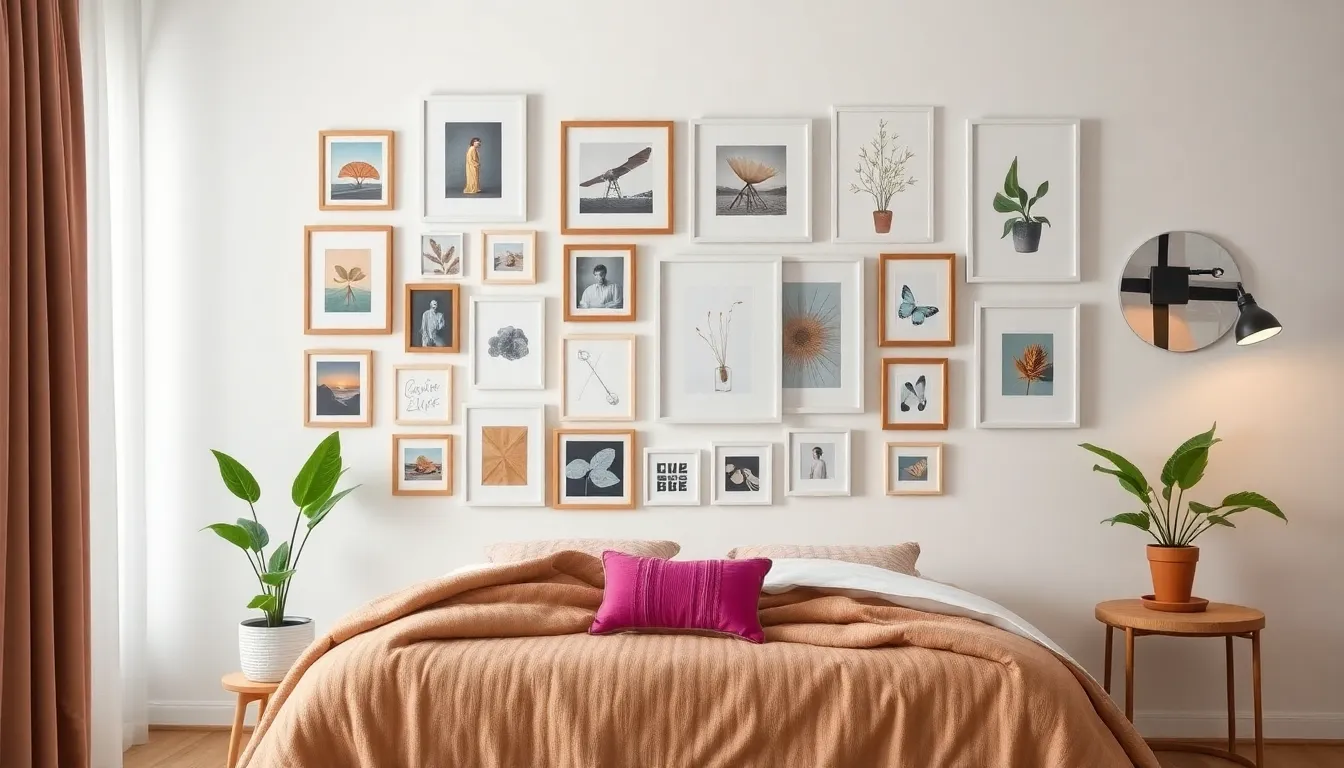
We believe personalizing your bedroom space through thoughtful art and accessories creates the deepest connection to your sanctuary. These finishing touches transform a generic room into a reflection of your unique personality and experiences.
Gallery Wall Arrangements
Gallery walls offer an excellent opportunity to showcase your artistic taste while creating a stunning focal point above your bed or dresser. We recommend combining different frame styles and sizes with various art pieces like prints, paintings, and photographs to establish a ever-changing visual display. Mixed media approaches work particularly well when you balance larger statement pieces with smaller complementary works.
Themed displays provide another effective strategy for gallery wall success. We suggest organizing your collection around a exact color palette or subject matter to enhance visual cohesion throughout the arrangement. Start by laying out your pieces on the floor before hanging them to perfect the composition.
Professional tip: We maintain consistent spacing of 2-3 inches between frames to create visual harmony while allowing each piece to breathe within the overall design.
Decorative Objects and Plants
Decorative objects serve as the jewelry of bedroom design, adding layers of visual interest and personal meaning to your space. We incorporate sculptural elements, vintage finds, and meaningful collectibles on nightstands, dressers, and floating shelves to create conversation starters and visual anchors.
Plants bring life and natural beauty into bedroom environments while improving air quality for better sleep. We recommend low maintenance options like snake plants, pothos, or peace lilies that thrive in bedroom lighting conditions. Hanging planters work exceptionally well for adding vertical interest without consuming valuable surface space.
Textural variety becomes crucial when selecting decorative objects. We mix smooth ceramics with rough woven baskets, polished metals with natural wood elements, and soft textiles with hard sculptural pieces to create depth and visual intrigue.
Personal Photos and Memorabilia
Personal photographs transform your bedroom into a true reflection of your life story and cherished relationships. We suggest creating dedicated display areas using picture ledges, small easels, or grouped frame collections rather than scattered individual photos throughout the room.
Memory displays offer creative ways to showcase personal mementos beyond traditional framing. We recommend shadow boxes for three dimensional keepsakes, vintage suitcases for storing and displaying collections, and decorative trays for organizing smaller meaningful objects on dresser tops.
Vintage elements mixed with contemporary pieces create unique atmospheric depth that reflects both your personal history and current style preferences. We encourage incorporating inherited furniture pieces, family heirlooms, or antique finds alongside modern accessories to establish rich visual storytelling throughout your bedroom sanctuary.
Utilize Mirrors to Enhance Space and Light
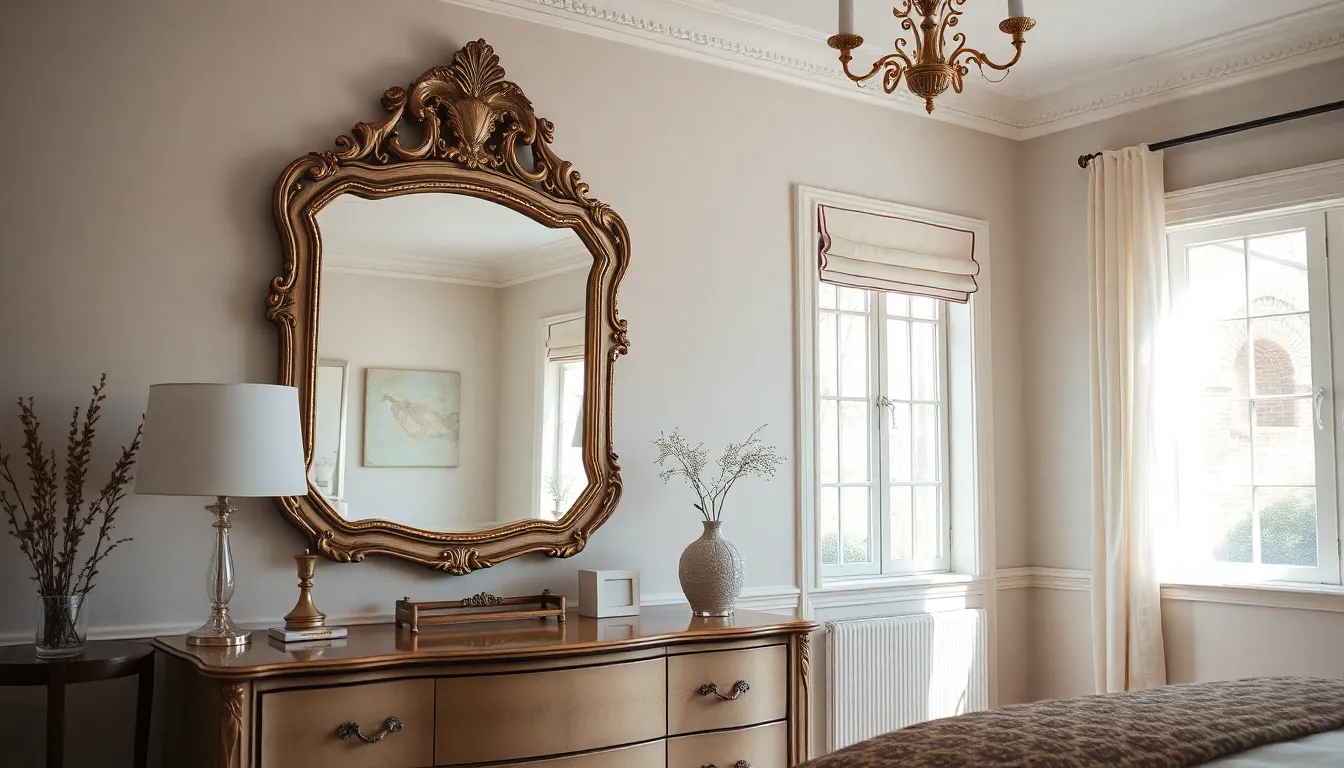
Mirrors serve as one of our most powerful allies in bedroom design, instantly expanding visual space while maximizing natural light throughout the room. Strategically placed mirrors near windows and doors can transform even the smallest bedrooms into bright, airy sanctuaries.
Full-Length Mirrors for Functionality
Full-length mirrors deliver both practical value and aesthetic appeal in our bedroom spaces. Position these versatile pieces next to bedroom doors to create an instant space-improving effect while providing a complete view for daily outfit checks. We recommend choosing mirrors that complement our existing decor style, whether that’s a sleek modern frame or an ornate vintage design.
Floor-standing mirrors work particularly well in corners where they won’t interfere with daily movement patterns. Leaning mirrors against walls creates a casual, contemporary look that’s easy to reposition as our design preferences evolve. Also, mirrored wardrobe doors serve double duty by providing full-length reflection while concealing storage areas.
Decorative Mirror Arrangements
Gallery walls featuring clustered mirrors in various shapes and sizes add ever-changing visual interest to our bedroom walls. Mix circular, rectangular, and hexagonal mirrors to create an captivating focal point that draws the eye upward and outward. We suggest starting with one larger anchor piece and surrounding it with smaller complementary mirrors for balanced composition.
Vintage mirrors with ornately carved frames bring unique character and historical charm to our bedrooms. Antique sunburst mirrors work especially well above dressers or reading nooks, while collection of small convex mirrors can create fascinating light patterns throughout the day. Grouping mirrors of similar finishes but different shapes maintains cohesion while adding textural variety to our walls.
Strategic Placement for Maximum Impact
Strategic mirror positioning amplifies both natural and artificial light sources in our bedrooms. Place mirrors directly across from windows to bounce daylight deeper into the room, effectively doubling the amount of natural illumination we receive.
| Placement Location | Primary Benefit | Additional Effect |
|---|---|---|
| Above the dresser | Classic decorative appeal | Creates grooming station |
| Behind table lamps | Amplifies artificial light | Adds warm ambient glow |
| Opposite windows | Maximizes natural light | Creates illusion of additional window |
| Adjacent to doors | Enhances spatial perception | Provides functional visibility |
Behind table lamps, mirrors create a beautiful glow effect when lights are illuminated, essentially doubling the warmth and brightness these fixtures provide. Avoid placing mirrors directly opposite our beds or bedroom doors, as this positioning can create restless energy according to Feng Shui principles and may disrupt peaceful sleep patterns.
Corner placement works exceptionally well for larger mirrors, as it opens up typically cramped spaces while providing practical functionality for daily routines.
Create Cozy Reading Nooks and Seating Areas

Reading nooks add intimate charm to our bedrooms while maximizing underutilized spaces. We can transform various bedroom areas into comfortable retreats that invite relaxation and quiet contemplation.
Window Seat Transformations
Storage integration makes window seats both beautiful and functional in our bedroom design. Built-in storage compartments beneath the seating area keep books, blankets, and personal items organized while maintaining clean sight lines throughout the room.
Comforting cushions transform basic window seats into luxurious seating experiences. Oversized pillows in soft fabrics create an inviting surface, while layered throw blankets add warmth and textural interest that complements our bedroom’s overall aesthetic.
Natural light streaming through nearby windows enhances the reading experience during daytime hours. We can install adjustable blinds or curtains to control brightness levels and create the perfect ambiance for different times of day.
Accent Chairs and Benches
Vintage touches bring character and personality to our bedroom seating areas. Antique chairs or refurbished pieces create focal points that tell stories while providing comfortable spots for reading or quiet reflection.
Patterns in upholstery create visually captivating elements that enhance our bedroom’s design scheme. Bold prints or subtle textures in chair fabrics can complement existing color palettes while adding depth to the overall room composition.
Positioning becomes crucial when placing accent chairs in our bedrooms. We should consider traffic flow and sight lines to ensure chairs enhance rather than obstruct the room’s natural movement patterns.
Corner Reading Spaces
Corner bookshelves optimize often overlooked spaces with floor-to-ceiling storage answers. These vertical installations maximize our bedroom’s storage capacity while creating impressive displays for book collections and decorative objects.
Personalized decor makes corner reading spaces feel intimate and uniquely ours. Custom artwork, family photos, and meaningful objects transform generic corners into personalized retreats that reflect our individual tastes and experiences.
Textural layers enhance the sensory richness of corner reading areas. Plush rugs underfoot, velvet cushions for seating, and woven throws create warmth and depth that invite extended reading sessions in comfort.
Biophilic decor elements bring natural touches to our corner spaces. Plants or botanical prints promote calming ambiance while improving air quality and connecting us with nature from within our bedroom sanctuary.
Incorporate Natural Elements for a Serene Environment

Natural elements transform our bedrooms into peaceful sanctuaries that connect us with the outdoors. These organic touches create a calming atmosphere that promotes better rest and relaxation.
Indoor Plants and Greenery
Plants breathe life into our bedroom spaces while purifying the air naturally. Hanging plants and vertical gardens add visual interest without consuming valuable floor space. We can create living walls that serve as stunning focal points while bringing natural beauty indoors.
Botanical prints offer an elegant way to introduce nature without maintenance requirements. Framed botanical illustrations and nature photography add sophisticated touches to our walls. These artistic elements complement living greenery perfectly.
Green accents in moss tones and muted oranges mimic nature’s palette effectively. These colors create harmony between our natural elements and overall design scheme. Bedding, throw pillows, and accessories in these hues reinforce our nature-inspired theme.
Natural Wood Accents
Wooden furniture with clean lines maintains modern aesthetics while adding warmth. Bed frames, nightstands, and dressers in natural wood create cohesive design elements. These pieces anchor our space with their substantial presence and organic beauty.
Raw and reclaimed wood finishes bring rustic charm to contemporary bedrooms. Oak, pine, and bamboo offer distinct grain patterns and textures that tell unique stories. Reclaimed materials add character while supporting sustainable design practices.
Minimalistic wooden designs prevent overwhelming our carefully curated spaces. Simple forms highlight the natural beauty of wood grain without competing with other elements. These pieces blend seamlessly with various decor styles while maintaining their organic appeal.
Stone and Organic Materials
Stone elements introduce texture and warmth through their natural variations. These materials create visual anchors that ground our design schemes effectively. Stone accents complement wooden furniture and plant life beautifully.
Organic fiber rugs in jute, sisal, and wool add tactile experiences underfoot. These natural materials provide comfort while reinforcing our connection to nature. Their neutral tones coordinate with various color palettes seamlessly.
Bedding made from organic cotton, linen, and bamboo enhances our sleep experience. These breathable materials regulate temperature naturally while feeling luxurious against our skin. Natural fibers age beautifully and become softer with each wash.
Maximizing natural light amplifies the beauty of our organic materials. Large windows and light-colored treatments allow sunshine to highlight wood grains and plant foliage. This interplay between light and natural elements creates ever-changing visual interest throughout the day.
Nature-inspired sounds complete our serene environment through audio elements. Sound machines featuring rain, birdsong, and forest sounds enhance our bedroom’s peaceful atmosphere. These auditory touches complement our visual natural elements perfectly.
Optimize Your Space With Smart Furniture Arrangements

Smart furniture placement can transform even the smallest bedroom into a functional and stylish retreat. We’ll explore strategic arrangements that maximize space while maintaining the beautiful aesthetic you’ve been building.
Small Bedroom Layout Ideas
Positioning your bed against a solid wall creates a natural focal point while maintaining clear pathways on both sides. This arrangement enhances movement throughout the room and provides the 75 cm of walking space needed for comfortable navigation. Wall-mounted desks and cabinets save valuable floor space while improving organization and storage capacity.
Built-in cabinets with integrated bed frames offer the ultimate space-saving solution. These custom pieces combine sleeping, storage, and workspace functions into one cohesive unit. Strategic placement of frequently used items like nightstands and dressers within arm’s reach of the bed eliminates unnecessary movement and maintains accessibility.
Vertical space utilization becomes crucial in compact bedrooms. Installing floating shelves above the headboard or around windows provides storage without cluttering floor areas. Corner spaces often go unused but can accommodate tall, narrow storage units or ladder-style shelving systems.
Multi-Functional Furniture Pieces
Storage beds with hidden compartments keep your room clutter-free while providing essential sleeping space. Black ottoman beds offer particularly stylish storage answers that complement various color schemes. Drawers built into bed frames eliminate the need for additional dressers or storage units.
Dual-purpose tables reduce furniture needs while increasing functionality. A desk that doubles as a dressing table serves both work and grooming needs without requiring separate pieces. Benches with internal storage provide seating while hiding seasonal items or extra bedding.
Nightstands with multiple tiers or built-in charging stations maximize bedside utility. These pieces combine traditional storage with modern technology needs. Ottomans that open for storage can serve as extra seating, footrests, and hidden storage simultaneously.
Creating Flow and Balance
Clear pathways ensure comfortable navigation throughout your bedroom space. Maintaining approximately 75 cm of walking space around major furniture pieces prevents the room from feeling cramped. Traffic flow should move naturally from the entrance to key areas like the bed, closet, and windows.
Strategic furniture placement creates visual balance while maintaining functionality. Positioning larger pieces like wardrobes or dressers opposite the bed creates symmetry without blocking natural light sources. Appropriate lighting and color choices visually expand the space while creating a cozy atmosphere.
Proportional relationships between furniture pieces establish harmony in the room. Matching the scale of your bedside tables to your bed frame creates visual continuity. Varying heights between furniture pieces adds visual interest while maintaining overall balance throughout the space.
Conclusion
We’ve explored countless ways to transform your bedroom into a personal sanctuary that reflects your unique style and meets your practical needs. From strategic color palettes and statement headboards to smart storage answers and cozy reading nooks every element plays a crucial role in creating your ideal retreat.
Remember that the best bedroom designs combine functionality with personal expression. Whether you’re working with a tight budget or ready to invest in luxury pieces the key is to choose elements that resonate with your lifestyle and bring you joy every day.
Start with one or two ideas that excite you most and build from there. Your bedroom should evolve naturally as your tastes and needs change creating a space that truly feels like home.
Frequently Asked Questions
What are the best color palettes for creating a relaxing bedroom atmosphere?
The article recommends three main approaches: warm neutrals like beige and cream for a cozy, inviting environment; cool tones such as blue and green to promote relaxation and reduce stress; and bold accent colors to add personality. For balance, bold hues should comprise only 20-30% of your overall color scheme while maintaining a cohesive palette throughout the space.
How can I create an impressive headboard on a budget?
DIY headboard options include repurposing old doors or creating fabric panel headboards for budget-friendly solutions. You can also opt for luxurious upholstered headboards in rich fabrics like velvet and linen. Consider softer, rounded forms to promote tranquility and elegance, making your headboard serve as the central design anchor of your bedroom.
What’s the best way to add texture and visual interest to my bedroom?
Layer different materials like plush rugs, velvet cushions, and woven throws to enhance warmth and depth. Mix bedding materials such as cotton for breathability, linen for sophistication, and silk for luxury. Use throw pillows, blankets, area rugs, and curtains strategically to create a rich sensory experience while coordinating colors and textures.
How can I maximize storage without compromising style?
Utilize under-bed storage with clear bins and rolling containers. Replace traditional nightstands with wall-mounted shelves or repurposed furniture for a clean aesthetic. Incorporate built-in shelving and customized closet systems to maximize vertical space. Choose multi-functional furniture pieces like storage beds and dual-purpose tables to maintain both functionality and style.
What lighting strategies work best for bedroom ambiance?
Combine ambient, task, and accent lighting for versatility. Use matching bedside table lamps for symmetry or wall-mounted sconces to save space. Install dimmer switches for adjustable brightness and central ceiling fixtures for overall mood. Add string lights for whimsy and LED strip lighting for modern accents to enhance architectural features and artwork.
How do I incorporate personal touches without cluttering the space?
Create gallery walls with mixed frame styles and art pieces organized around a cohesive color palette or theme. Add decorative objects and low-maintenance plants that thrive in bedroom conditions. Display personal photographs and memorabilia creatively, blending vintage and contemporary elements to create a narrative that reflects your unique personality.
Where should I place mirrors to maximize their impact?
Position mirrors strategically to amplify natural light and create the illusion of larger space. Use full-length mirrors for both functionality and aesthetic appeal. Create decorative mirror arrangements for visual interest, but avoid placing mirrors directly opposite beds to maintain a peaceful atmosphere. Focus on placement that enhances spatial perception and light sources.
What natural elements can I add to create a serene bedroom environment?
Incorporate indoor plants and greenery for air purification and visual appeal. Use hanging plants and vertical gardens to save floor space. Add botanical prints, green accents in bedding, natural wood accents, and stone materials. Choose organic fiber rugs and natural material bedding while maximizing natural light and considering nature-inspired sounds for tranquility.
How can I optimize furniture arrangement in a small bedroom?
Position your bed against a solid wall as a focal point. Utilize wall-mounted desks and cabinets to save floor space. Incorporate built-in cabinets that combine sleeping and storage functions. Use vertical space with floating shelves and corner storage solutions. Maintain clear pathways for navigation and achieve visual balance through proportional furniture relationships.

